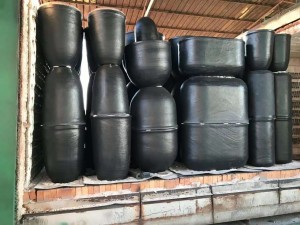
Crucibles are important components of chemical apparatus and serve as containers for melting and refining metal liquids, as well as for heating and reacting solid-liquid mixtures. They form the foundation for ensuring smooth chemical reactions.
Crucibles can be divided into three main categories: graphite crucibles, clay crucibles, and metal crucibles.
Graphite crucibles are primarily made from natural crystalline graphite, retaining the various physical and chemical properties of natural graphite. They possess good thermal conductivity and high temperature resistance. During high-temperature usage, they exhibit low thermal expansion coefficients, making them resistant to rapid heating and cooling. Graphite crucibles have strong corrosion resistance to acidic and alkaline solutions and demonstrate excellent chemical stability.
Due to these superior characteristics, graphite crucibles are widely used in industries such as metallurgy, casting, machinery, and chemical engineering. They find extensive application in the smelting of alloy tool steels and the melting of non-ferrous metals and their alloys, offering notable technological and economic benefits.
Silicon Carbide Crucibles:
Silicon carbide crucibles are bowl-shaped ceramic containers. When solids need to be heated at high temperatures, crucibles are necessary because they can withstand higher temperatures compared to glassware. Crucibles are usually not filled to capacity during usage to prevent the heated material from spilling over, allowing air to freely enter and facilitate possible oxidation reactions. Due to their small base, crucibles are typically placed on a clay triangle for direct heating. They can be positioned upright or at an angle on an iron tripod, depending on the experimental requirements. After heating, crucibles should not be immediately placed on a cold metal surface to avoid rapid cooling and potential breakage. Similarly, they should not be placed directly on a wooden surface to prevent scorching or fire hazards. The correct approach is to allow the crucibles to cool naturally on the iron tripod or place them on an asbestos net for gradual cooling. Crucible tongs should be used for handling.
Platinum Crucibles:
Platinum crucibles, made of the metal platinum, serve as spare parts for differential thermal analyzers and are used for heating non-metallic materials, such as glass fiber production and glass drawing.
They should not come into contact with:
Solid compounds such as K2O, Na2O, KNO3, NaNO3, KCN, NaCN, Na2O2, Ba(OH)2, LiOH, etc.
Aqua regia, halogen solutions, or solutions capable of generating halogens.
Compounds of easily reducible metals and the metals themselves.
Carbon-containing silicates, phosphorus, arsenic, sulfur, and their compounds.
Nickel Crucibles:
The melting point of nickel is 1455 degrees Celsius, and the temperature of the sample in a nickel crucible should not exceed 700 degrees Celsius to prevent oxidation at high temperatures.
Nickel crucibles are highly resistant to alkaline substances and corrosion, making them suitable for melting iron alloys, slag, clay, refractory materials, and more. Nickel crucibles are compatible with alkaline fluxes such as NaOH, Na2O2, NaCO3, and those containing KNO3, but they should not be used with KHSO4, NaHSO4, K2S2O7, or Na2S2O7 and sulfide fluxes with sulfur. Melting salts of aluminum, zinc, lead, tin, and mercury can render nickel crucibles brittle. Nickel crucibles should not be used for burning precipitates, and borax should not be melted in them.
Nickel crucibles often contain trace amounts of chromium, so caution must be exercised when, session interrupted.
Post time: Jun-18-2023
